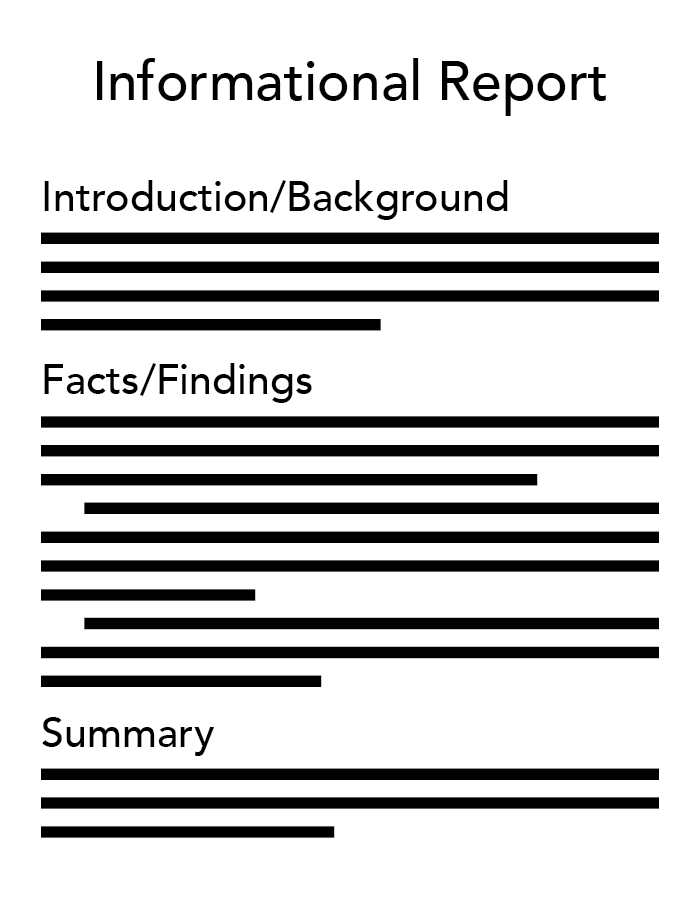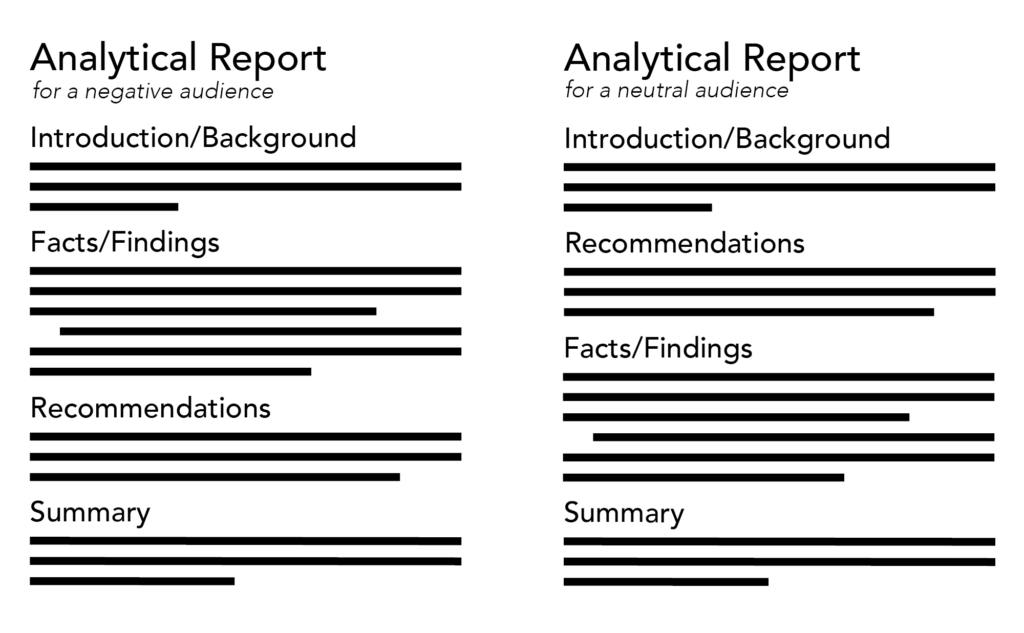Informal informational reports typically include the following three sections:
- Introduction or background
- Support or reasons
- Summary
Informal analytical reports typically include the following four sections:
- Introduction or background
- Support or reasons
- Recommendations
- Conclusion or summary
Introduction or Background
A short section introducing the reader to the “why” of the report. In more complex reports, the introduction may include a background, a problem statement, specific objectives, or all of the above.
Support or Reasons
This is where you’ll include your facts, findings, and data. Writers new to reports may make the mistake of providing lists of data and other information found as a result of research. However, most business managers can find the information on their own with time. The purpose of this section of a report is to present a summary of main ideas from the research—it’s not simply a collection of raw data.
If more detailed data is needed, an appendix is the most likely place for key selections of raw data.
This section may include the methodology of the research.
Recommendations
This section is only found in analytical reports; it shows how data supports the recommendation given in the report. Essentially, the author connects the logical data items in a way that points to the recommendation.
Remember, the readers are expecting a recommendation with supporting data; they’re not expecting to work through all the data on their own.
Conclusion or Summary
This short section wraps up the report and gives a quick summary of the information provided therein.
Organizing based on Audience Analysis
The logic of report organization is the same as the logic discussed in Module 2 for shorter messages. Reports analyze the audience the same way. The difference lies in the depth of information needed. Thinking about your audience, or the stakeholders, is one of the most crucial considerations when creating a report. It’s important to keep in mind that your audience may be broader than you expect (remember the discussion on types of stakeholders from earlier this module): your potential readers have an interest in the report’s content for many reasons based on their unique job functions.
To determine which types of sections you should use in your informal report, think about the purpose of the report (these sections can take inspiration from the standardized sections used in formal reports, which we will discuss in-depth later) in relation to your audience.
Organizing Your Report

Figure 1. Informational Report Organization
If your audience is expected to react neutrally or positively to your message, then your conclusion or recommendation should be offered near the beginning of the report. Thus, your report would be laid out like this. First you would write the introduction, background, or problem section. Next come your conclusions or recommendations. These are backed up by the support or reasons section, which details facts, data, or findings. The final section is typically some sort of further discussion, analysis, or summary. Remember that introducing these sections with a descriptive heading can help your readers, especially if the sections consist of multiple paragraphs.
If the audience is expected to react negatively to your message, then the conclusion or recommendation is offered towards the end of the report. This alternate organization allows the reader to reach a similar conclusion to yours based upon the research and logic offered. Thus, your report would be laid out like this: First you would write your introduction, background, or problem. The next section will be the support or reasons section, which details facts, data, or findings that led you to your conclusion. Next you would include discussion, analysis, or summary. This sections is where the logical or emotional arguments that may influence the reader’s understanding are made. Your report then concludes with your conclusions or recommendations. Remember that introducing these sections with a descriptive heading can help your readers, especially if the sections consist of multiple paragraphs.

Figure 2. Analytical Report Organization
While informal reports may not use extensive or standardized labeling of sections, nor do they have required length of individual sections, each section has a unique purpose. However, these “sections” may be a couple of paragraphs rather than a fully separated section with their own headings. As the report starts to exceed a page or two, headings will provide a tremendous benefit to the reader, and to you, as the reader better understands and retains your main ideas.
A Quick Comparison: Using Headings?
Take a look at these two dummy texts to compare the structure of an informal report without headings and an informal report that uses headings. (Note that these examples only show the formatting of a report, not the ideal way to write one.)
| No Headings | Using Headings |
|---|
| General Store is opening a new location in Q4 of this upcoming year. There are three potential locations for this new store. In my research, I found that location one is in a poorly trafficked area, but is more affordable. Location two is in a highly trafficked area, but is out of the current budget. Location three is just right. After this research, I can conclude that General Store should open its new store at location three. | Background General Store is opening a new location in Q4 of this upcoming year. There are three potential locations for this new store. Findings Location one is in a poorly trafficked area, but is more affordable. Location two is in a highly trafficked area, but is out of the current budget. Location three is just right. Recommendation General Store should open its new store at location three. |
Headings can be a useful tool for helping your readers navigate directly to the information they want. Notice that the headings catch your reader’s eye much more easily than phrases such as “in my research . . . ”

